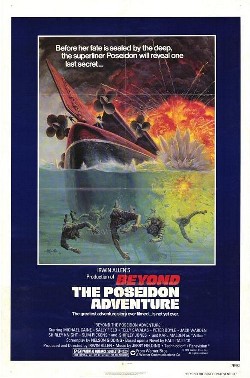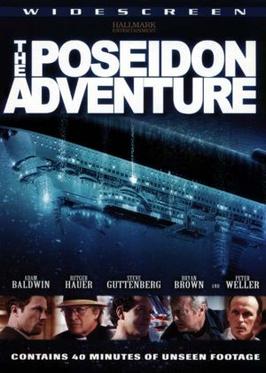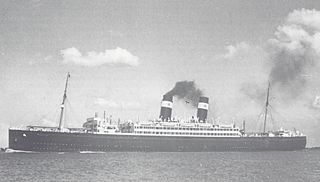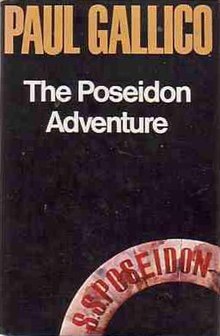Plot
Formerly the RMS Atlantis, the SS Poseidon is a luxury ocean liner from the golden age of travel, converted to a single-class, combination cargo-cruise liner. The ship is on her first North Atlantic crossing under new ownership, celebrated with a month-long Christmas voyage from Lisbon to African and South American ports. [1] On December 26, an undersea earthquake overturns the Poseidon. The ship capsizes as it falls into the void caused by the quake displacing millions of gallons of seawater.
Stuck within the upper deck dining room, preacher Reverend Frank "Buzz" Scott suggests his fellow survivors to move to the keel of the ship, where maybe they will have more chances of being rescued. Those who refuse to follow him stay behind.
The rest climb a Christmas tree with Scott to ascend into the galley area where they meet stewards and kitchen crew. The group debates whether to try to reach a propeller shaft at the stern, or to go to the bow. A steward fears the lockers that hold the anchor chains will have flooded, and suggests trying for the engine room.
After climbing two upside-down stairways, the group comes upon "Broadway", a wide service corridor that runs the length of the ship and connects to the engine room. The posse breaks for a while whilst looking for supplies. Young Robin Shelby ventures off to find the bathroom while Tony "The Beamer" Bates and his girlfriend Pamela find the liquor closet. When the ship's emergency lighting goes out, some crew members panic and stampede; they are trampled, or killed by falling over stairway openings or into a pit where a boiler tore through several decks. After the panic, Scott's group searches for Tony, Pamela, and Robin.
New York Police Detective Mike Rogo finds Tony passed out, intoxicated, and Pamela refuses to leave him. While searching for Robin, his older sister Susan is raped by Herbert, a young, terrified crew member. Susan talks with Herbert, who is remorseful and ashamed, and grows to like him. Realizing the consequences of his actions, Herbert panics, runs off and falls to his doom. Susan rejoins the group and tells them nothing of what has happened.
After an intense search, they make the decision to move on without Robin. His mother, Jane, breaks down and vents her long-held disgust and hatred for her husband. The Reverend, having found a Turkish oiler, guides the other survivors to the stern. They find a corridor to the engine room, which is completely submerged. Belle Rosen, a former W.S.A. champion, swims through the corridor and finds the passage to get them to the other side. Upon their arrival, they find the engine room.
They take time to rest and save the batteries on their recently acquired flashlights. In the darkness, Linda Rogo makes a move on the Reverend. After their rest, they see the way out—five decks up, on top of a fractured steel wall. During the difficult climb, Linda rebels and attempts to find her own way. She chooses an unstable route and falls to her death, impaled on a piece of steel. An explosion rocks the ship, and Reverend Scott, enraged, denounces God, offers himself as a sacrifice, and commits suicide. Mary Kinsale, an English spinster, screams in grief and claims they were to be married. Her fellow survivors do not know what to make of this revelation.
Mr. Martin takes charge of the group, who make their way into a propeller shaft where the steel hull is at its thinnest. The oxygen supply begins to give out, but after much waiting, they are found. Belle Rosen has a heart attack and dies before the rescue team can reach her. The team cuts through, and the group climb out of the upturned hull. Manny Rosen, however, refuses to leave without Belle's remains, which are lifted out after the others have left. Once outside, the survivors see another, much larger group of survivors being removed from the bow of the ship. Most are still in their dinner clothes, in contrast to Scott's group, who are mostly in underclothing and streaked with oil.
En route to the rescue ships in lifeboats, they see Tony and Pamela, who have survived after all. Sailors from a small German tramper try to put a salvage line on the Poseidon. Mike curses them because of his World War II experiences and laughs when their efforts fail. The group goes their separate ways—Mary Kinsale and Nonnie on a ship back to England; Mike, Manny, Hubie Muller back to New York, Martin back to Chicago, Dick, Jane and Susan back to Michigan; and the Turk back to Turkey. Aboard the American ship, they watch the Poseidon sink. Jane, giving up hope, silently grieves the loss of her son.
Susan, meanwhile, dreams of going to Hull in England to visit Herbert's parents. She hopes to be pregnant with his child so he would have a legacy.

Harold "Jack" Albertson was an American actor, comedian, dancer and singer who also performed in vaudeville. Albertson was a Tony, Oscar, and Emmy winning actor, which ranks him among a rare stature of 24 actors who have been awarded the "Triple Crown of Acting".’

SS Andrea Doria was a luxury transatlantic ocean liner of the Italian Line, put into service in 1953. She is widely known from the extensive media coverage of her sinking in 1956, which included the remarkably successful rescue of 1,660 of her 1,706 passengers and crew.

USS Charger (CVE-30) was an escort carrier of the United States Navy during World War II converted from a commercial C3-P&C cargo/passenger liner hull built as Rio de la Plata intended for the Moore-McCormack company's American Republics Line serving the east coast of South America. The ship was requisitioned for conversion to an escort carrier type intended for Royal Navy use and initially commissioned as HMS Charger (D27). Days later the transfer was rescinded with the ship returning to U.S. Navy control to become USS Charger which operated throughout the war as a training ship on the Chesapeake Bay with two ferry missions to Bermuda and Guantánamo Bay, Cuba.

The Poseidon Adventure is a 1972 American disaster film directed by Ronald Neame, produced by Irwin Allen, and based on Paul Gallico's 1969 novel of the same name. It has an ensemble cast including five Oscar winners: Gene Hackman, Ernest Borgnine, Jack Albertson, Shelley Winters, and Red Buttons. The plot centers on the fictional SS Poseidon, an aging luxury liner on her final voyage from New York City to Athens, before it is scrapped. On New Year's Day, it is overturned by a tsunami. Passengers and crew are trapped inside, and a preacher attempts to lead a small group of survivors to safety.

MS St. Louis was a diesel-powered passenger ship properly referred to with the prefix MS or MV, built by the Bremer Vulkan shipyards in Bremen for HAPAG, better known in English as the Hamburg America Line. The ship was named after the city of St. Louis, Missouri. Her sister ship, MS Milwaukee, was also a diesel powered motor vessel owned by the Hamburg America Line. St. Louis regularly sailed the trans-Atlantic route from Hamburg to Halifax, Nova Scotia, and New York City, and made cruises to the Canary Islands, Madeira, Spain; and Morocco. St. Louis was built for both transatlantic liner service and for leisure cruises.

SS France was a Compagnie Générale Transatlantique ocean liner, constructed by the Chantiers de l'Atlantique shipyard at Saint-Nazaire, France, and put into service in February 1962. At the time of her construction in 1960, the 316 m (1,037 ft) vessel was the longest passenger ship ever built, a record that remained unchallenged until the construction of the 345 m (1,132 ft) RMS Queen Mary 2 in 2004.

Poseidon is a 2006 American action disaster film directed and co-produced by Wolfgang Petersen. It is the third film adaptation of Paul Gallico's 1969 novel The Poseidon Adventure, and a loose remake of the 1972 film. It stars Kurt Russell, Josh Lucas and Richard Dreyfuss with Emmy Rossum, Jacinda Barrett, Mike Vogel, Mía Maestro, Jimmy Bennett and Andre Braugher in supporting roles. It was produced and distributed by Warner Bros. in association with Virtual Studios. It had a simultaneous release in IMAX format. It was released on May 12, 2006, and it was criticized for its script but was praised for its visuals and was nominated at the 79th Academy Awards for Best Visual Effects. It grossed $181.7 million worldwide on a budget of $160 million; however, after the costs of promotion and distribution, Warner Bros. lost $70–80 million on the film, making it a box-office bomb as a result.

Beyond the Poseidon Adventure is a 1979 American disaster film and a sequel to The Poseidon Adventure (1972) directed by Irwin Allen and starring Michael Caine and Sally Field. It was a critical and commercial failure, and was the only Allen disaster film to receive no Academy Award nominations. Its box office receipts were only 20% of its estimated $10 million budget.

SOS, known in Japan as Septentrion, is a survival adventure video game developed by Human Entertainment and published in 1994 by Vic Tokai for the Super NES. A sequel to the game was later released in Japan for the PlayStation known as Septentrion: Out of the Blue.

Between Two Worlds is a 1944 American World War II fantasy drama film starring John Garfield, Paul Henreid, Sydney Greenstreet, and Eleanor Parker. It is a remake of the film Outward Bound (1930), itself based on the 1923 play Outward Bound by Sutton Vane. It is not, as is sometimes claimed, a remake of Fritz Lang's Destiny.
"The Wettest Stories Ever Told" is the eighteenth episode of the seventeenth season of the American animated television series The Simpsons. It originally aired on the Fox network in the United States on April 23, 2006.

When Time Ran Out... is a 1980 American disaster film directed by James Goldstone and starring Paul Newman, Jacqueline Bisset and William Holden. The supporting cast features James Franciscus, Ernest Borgnine, Red Buttons, Burgess Meredith, Valentina Cortese, Veronica Hamel, Pat Morita, Edward Albert and Barbara Carrera.

The Poseidon Adventure is a 2005 American made-for-television disaster film based on Paul Gallico's 1969 novel of the same name. It is a loose remake of the 1972 film of the same name and its 1979 sequel.

RMS Titanic sank on 15 April 1912 in the North Atlantic Ocean. The largest ocean liner in service at the time, Titanic was four days into her maiden voyage from Southampton to New York City, with an estimated 2,224 people on board when she struck an iceberg at 23:40 on 14 April. Her sinking two hours and forty minutes later at 02:20 ship's time on 15 April, resulted in the deaths of more than 1,500 people, making it one of the deadliest peacetime maritime disasters in history.

The crew of the Titanic were among the estimated 2,240 people who sailed on the maiden voyage of the second of the White Star Line's Olympic-class ocean liners, from Southampton, England, to New York City in the United States. Halfway through the voyage, the ship struck an iceberg and sank in the early morning of 15 April 1912, resulting in the deaths of over 1,500 people, including approximately 688 crew members.

SS Orsova, was a British ocean liner, built by Vickers Armstrong in Barrow-in-Furness, England, for the Orient Steam Navigation Company for their Great Britain-to-Australia services via the Suez Canal. She was the final development of the 28,000 ton class which began with the SS Orcades of 1948 and continued with the SS Oronsay of 1951. In 1960, in conjunction with the introduction of the new larger and faster Oriana and Canberra, the fleets of Orient and P&O were combined as P&O-Orient Lines, although the Orient ships retained their corn-coloured hulls and sailed under their own house flag. In 1966, P&O acquired the balance of the Orient shares and the Orient Line was discontinued, with Orsova and her fleet mates being transferred to the ownership of the Peninsular & Oriental Steam Navigation Company (P&O), painted white and under the P&O houseflag.

RML 497 is a former Royal Navy Fairmile B motor launch from World War II. She was named Western Lady III on her entry to civilian service, as a passenger motor vessel for Western Lady Ferry Service. From 2009 to 2015, she operated as The Fairmile for Greenway Ferry on their day cruise route from Torquay and Brixham to Dartmouth and Greenway. In May 2013, she was returned to her original wartime appearance. Torbay's "ferry wars" forced her removal from service, and in December 2015, RML 497 was acquired by the National Museum of the Royal Navy.

Lifeboats played a crucial role during the sinking of the Titanic on 14–15 April 1912. The ship had 20 lifeboats that, in total, could accommodate 1,178 people, a little over half of the 2,209 on board the night it sank.

SS Pennland was a transatlantic ocean liner that was launched as Pittsburgh in Ireland in 1920 and renamed Pennland in 1926. She had a succession of UK, German and Dutch owners and operators. In 1940 she was converted into a troopship.
MV Walmer Castle was a UK cargo liner. She was launched in 1936 in Northern Ireland, and was the smallest ocean-going ship in the Union-Castle Line fleet. For three years she provided a scheduled weekly cargo feeder service linking Union-Castle liners that terminated at Southampton with the German ports of Bremen and Hamburg.


















